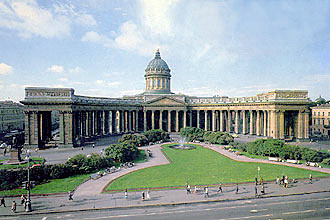We continue our virtual tour in St Petersburg. Welcome back, mind travelers! Today we schlep around on foot along and near the main drag in town, the
Nevsky Prospekt. Here is a bit from the link you will find by clicking above.
The most famous street in Russia, Nevsky (Nevskiy) Prospekt in St. Petersburg was planned by the French architect Alexandre Jean Baptiste LeBlond, whilst working for the city's founder Peter the Great.
This proud landmark originally called the Great Perspective Road was cut through 4.5 km of forest land (c1718) and for many years was roamed by wolves. Stretching from the historic Admiralty in the north to the Alexander Nevsky Monastery, it is renowned for its splendid architecture and famous former patrons, like Tchaikovsky, Gogol, Rimsky-Korsakov and Nijinsky. Today it thrives with great prospects for both locals and tourists alike, as the magnetic heart of the city.
It's a great street for strolling, and that is what we did on Sunday.

The photo above is the statue to Field Marshal Kutuzov, located in front of the Kazan Cathedral.
Prince Mikhail Illarionovich Golenishchev-Kutuzov (Russian: князь Михаил Илларионович Голенищев-Кутузов) (September 16 [O.S. September 5] 1745 — April 28 [O.S. April 16] 1813) was the Russian Field Marshal popularly credited with saving his country from Napoleon's invasion.

Here is the inscription at the base of the statue: "To Field Marshal Prince Kutuzov of Smolensk." The inscription incorporates one of his
titles.
Kutuzov now held the rank of Field Marshal and had been awarded the victory title of His Serene Highness Knyaz Smolensky (Светлейший князь Смоленский) - having achieved this title for a victory over part of the French army at Smolensk in November 1812.
Wikipedia discusses his monuments thus:
Early in 1813 Kutuzov fell ill and died on 28 April 1813 at Bunzlau. Memorials have been erected to him at that place, at the Poklonnaya Hill in Moscow and in front of the Kazan Cathedral, St Petersburg, where he is buried. As he had no male issue, his estates passed to the Tolstoy family. Among Russian generals Kutuzov has been held second only to his teacher Suvorov. Alexander Pushkin addressed the Field Marshal in the famous elegy on Kutuzov's sepulchre, and he also figures as a wise and popular leader in Leo Tolstoy's War and Peace. During the Great Patriotic War (1941-45), the Soviet government established the Order of Kutuzov which, among several other decorations, was preserved in Russia upon the dissolution of the Soviet Union, thus remaining of the highest military awards in Russia.
As this passage indicates, Kutuzov is buried inside the cathedral and we paused before his tomb when we went inside and I prayed there for victims of war.
A further
note on the Patriotic War (1812):
When Napoleon invaded Russia in 1812, Michael Andreas Barclay de Tolly (then Minister of War) chose to follow the scorched earth principle and retreat rather than to risk a major battle. His strategy aroused grudges from most of the generals and soldiers, notably Prince Pyotr Bagration. Therefore, when Kutuzov was appointed commander-in-chief and arrived to the army on August 17, he was greeted with delight.
Within two weeks Kutuzov decided to give major battle on approaches to Moscow. Two huge armies clashed near Borodino on 7 September 1812 in what has been described as the greatest battle in human history up to that date, involving nearly a quarter of a million soldiers. The result of the battle was inconclusive, with a quarter of the French and half of the Russian army killed or wounded. After the famous conference at the village of Fili, Kutuzov fell back on the strategy of his predecessor: withdraw in order to save the Russian army as long as possible.
[It is commonly stated that it was the Russian winter that defeated Napoleon. The reference to the
battle of
Borodino--
virtual tour here--strikes a chord with me. It is inscribed around Napoleon's tomb in Paris, which I have visited (and the little conqueror was never a hero of mine). There is a Russian song about the Battle of Borodino that I have heard sung by
Slavyanka, the male chorus based in San Francisco and taking its name from the Russian River north of there (called Slavyanka by the Russian settlers in Northern California). There is so much defiance in that song and the word "Fransuzu" is positively spat out. ]
"Of all my 50 battles, the most terrible was the one I fought at Moscow (Borodino)"- Napoleon  The Dom Knigi
The Dom KnigiOver on the north side at 28, is the former HQ of the Singer Sewing Machine Company, which is now Dom Knigi, the largest book store in town (But they don't accept credit cards!). (Source)
This building is still identified by tour guides as the former Singer Sewing Machine building. It stands out for its distinctive (quirky?) architecture in its context.

Looking across the park in front of the Kazan Cathedral toward other buildings on the north side of Nevsky Prospekt.

Then panning a bit to the left.
More to come.
--the BB
 This is a 19th century painting of Kazan Cathedral (source: Wikipedia; public domain)
This is a 19th century painting of Kazan Cathedral (source: Wikipedia; public domain)
 Here is my photo of the end of one of the colonnades, the one near the statue of Kutuzov.
Here is my photo of the end of one of the colonnades, the one near the statue of Kutuzov. Here you can see the pediment and the dome.
Here you can see the pediment and the dome. This photo can give you an idea of the massive scale of the cathedral. The ladies at the foot of the stairs were begging for alms.
This photo can give you an idea of the massive scale of the cathedral. The ladies at the foot of the stairs were begging for alms.













































